
Seoul Subway Line 4 of the Seoul Metropolitan Subway is a long line crossing from the southwest to the northeast across the Seoul National Capital Area. The central section in Seoul City is operated by Seoul Metro with some trains offering through service to Korail's Ansan and Gwacheon Lines. The southern terminus (Oido) is in Jeongwang 4-dong, Siheung City, and the northern terminus (Jinjeop) is in Jinjeop-eup, Namyangju-si, Gyeonggi-do; the newly built northern section is correspondingly owned by a company owned by Namyangju-si, with operations contracted to Seoul Metro. In 2022, the Seoul Metro operated section had an annual ridership of 219,587,000 or about 601,608 passengers per day.

Seoul Subway Line 9, operated by Seoul Line9 Operation, is a subway line in Seoul, part of the Seoul Metropolitan Subway. The line runs east from Gaehwa station or Gimpo International Airport station along the south bank of the Han River towards VHS Medical Center in Gangdong. In 2019, Line 9 had an annual ridership of 225 million or about 616,000 people per day.
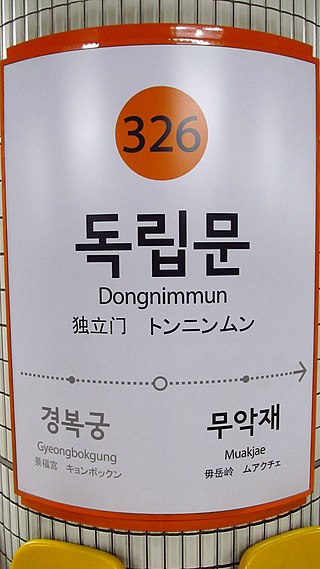
Dongnimmun Station (Korean: 독립문역) is a station on the Seoul Subway Line 3 in Seodaemun-gu, Seoul. It is named after the nearby Independence Gate.

Sangwangsimni Station is a station on Seoul Subway Line 2 in Seongdong-gu, Seoul, South Korea.

Jamsil Station is an underground station on Line 2 and Line 8 of the Seoul Metropolitan Subway. Lotte World is continuous with the Line 2 station. The station is also called Songpa-gu Office Station (송파구청역), due to the proximity of the office building.
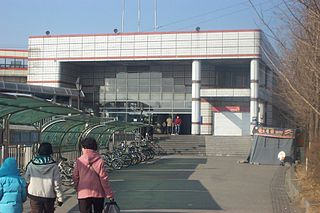
Guil Station (Korean: 구일역) is a subway station in Seoul, South Korea, that serves Seoul Subway Line 1. The name of this station comes from its location within Guro 1 -dong. Dongyang Mirae University is located nearby.
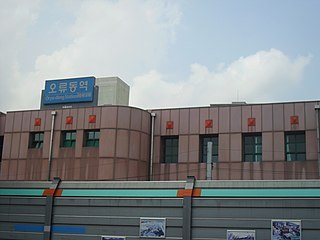
Oryu-dong station is a metro station on Line 1 of the Seoul Subway. It was opened when the Seoul–Incheon line was first introduced during the Japanese occupation era.

Gwangmyeong station (Korean: 광명역) is a train station in Gwangmyeong, South Korea. The station was newly built as a stop of national railway operator Korail's KTX high-speed service, 22.0 km (13.7 mi) south of Seoul Station.

Onsu Station is a station on the Seoul Subway Line 1. It was the former western terminus of Seoul Subway Line 7. A westward extension of Line 7 was completed in October 2012. It is near the border of Seoul and Bucheon.

Sosa Station is a station on Seoul Subway Line 1 and Seohae Line in Bucheon City, west of Seoul.
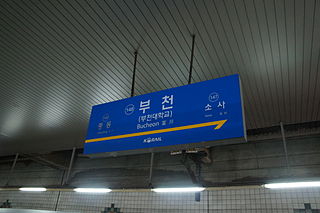
Bucheon Station is a ground level metro station located in Bucheon, South Korea. This station is on Seoul Subway Line 1. It was also once the southern terminus of the Gimpo Line, until its abandonment in 1980.

Songnae Station is a station on Seoul Subway Line 1. It is an above-ground station located in the city of Bucheon, South Korea. It provides access to many restaurants and other services, including the Toona Shopping Center.
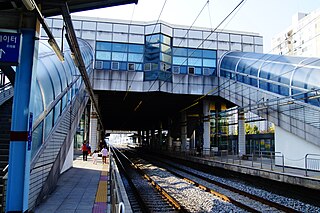
Bugae Station is a subway station located in Bupyeong-gu, a district in Incheon, South Korea. This station is on the Seoul Subway Line 1.
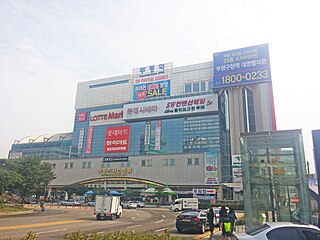
Bupyeong station is a subway station located in Bupyeong District, a district in Incheon, South Korea. This station is on the Seoul Subway Line 1 and Incheon Subway Line 1. It is one of the busiest stations on the Incheon line because of its central location and its connection to the Seoul line.

Gyeongbokgung station (Korean: 경복궁역) is a subway station on Line 3 of the Seoul Metropolitan Subway. It is the subway station nearest to the Gyeongbokgung Palace. The station is also near the Government Complex–Seoul, the National Police Agency of South Korea, and other administrative buildings in the neighborhood.
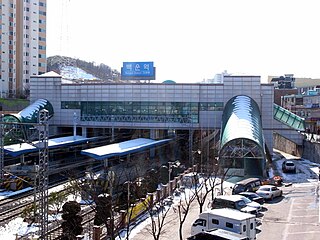
Baegun Station is a subway station on the Seoul Subway Line 1 and the Gyeongin Line.

Incheon Subway Line 2 is a driverless, medium-capacity subway line running 29.2 km (18.1 mi) from Oryu-dong in Seo-gu to Incheon Grand Park, with 27 stations, part of the Incheon Subway system. The line is also included as a part of the overall Seoul Metropolitan Subway network; Juan station has a free transfer with Seoul Subway Line 1, Geomam station connects with the AREX Line to Incheon International Airport and Seoul Station, and Seongnam also has a free transfer with Seoul Subway Line 7.
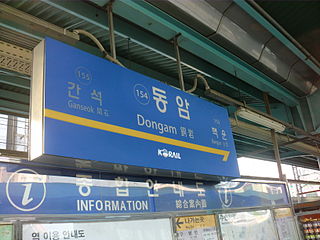
Dongam Station is a station on Seoul Metropolitan Subway Line 1 and Gyeongin Line.

Juan station is a subway station on the Seoul Metropolitan Subway Line 1 and Incheon Subway Line 2. This station receives the second-highest number of crowds along the entire Incheon line due to its proximity to the downtown area. It is also near Inha University and Inha Technical College.
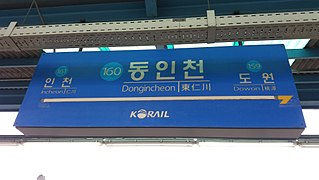
Dongincheon Station is a railway station on Seoul Metropolitan Subway Line 1 and Gyeongin Line located in Inhyeon-dong, Jung-gu, Incheon. Upon its opening in 1899, the station was known as "Chukhyeon Station", and in 1955, received its current name. The subway service started in 1974.





















